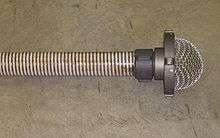Drafting water

The term drafting water refers to the use of suction to move a liquid such as water from a vessel or body of water below the intake of a suction pump. A rural fire department or farmer might draft water from a pond as the first step in moving the water elsewhere. A suction pump creates a partial vacuum (a "draft") and the atmospheric pressure on the water's surface forces the water into the pump, usually via a rigid pipe (sometimes called a dry hydrant) or a semi-rigid hard suction hose.[1][2]
Standard atmospheric pressure is 101 kPa (14.7 lbf/in²) and that can only raise water to a theoretical maximum of 10.3 metres (33.9 ft).[3] Depending on application, fire department pumps lift water 6 to 10 metres (20 to 30 ft).

To reduce drafting friction and obtain a larger flow or higher lift, a larger cross-section of suction hose is employed. For example, using a five-inch (127 mm) hose, a pump that could lift 500 US gallons per minute (30 L/s) up 23 feet (7 m) would only be able to lift the same amount of water 12.5 feet (4 m) through a 3.5-inch (76 mm) hose. Fire engines are often seen carrying two or three 10-foot (3 m) lengths of suction hose, but the longer the lift, the lower the flow, for a fixed-diameter suction hose and a given pump. Multiple relays could be used if the need arises, with a suction pump drafting up to 10 metres (30 ft) and discharging at great distances.
It is also possible to use a gravity siphon to draft water for a small lift, and this technique is often used in forest fire suppression, where portable reservoirs of 1,000 to 3,000 US gallons (5 to 10 m³) are filled with water and small hoses are used downhill of the tanks. The nozzle pressure is proportional to its distance below the reservoir surface. Forty-three percent of the distance, in feet, is approximately the number of pounds per square inch pressure (e.g., 100 feet lower: 43 psi). The tank may itself be gravity-fed through hoses from a nearby water source, or by pumps or helicopters delivering water from further away.
See also
References
- ↑ Corbett, Glenn. Fire Engineering's Handbook for Firefighter I and II. p. 434.
- ↑ Lowell Fire Department. Drafting Drill (PDF).
- ↑ Jimenez, Dan. "3.5 Drafting Guidelines". Firefighter Math.